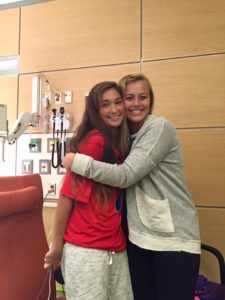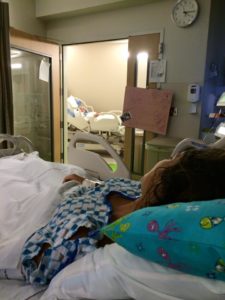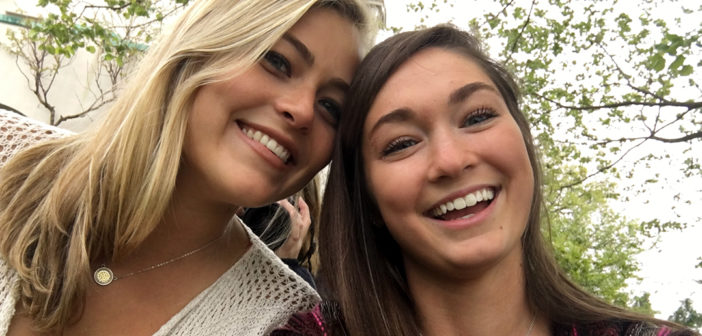Megan Kienzle was scared.
As they wheeled her into the operating room all she could think was, “She’s going to die if I don’t do this.”
As much as the 10-hour liver transplant scared her, losing Leanne Purcell scared her more.
She was Leanne’s last hope.
At the end of August 2015, Leanne was experiencing a lot of stomach pain. She and her family weren’t worried, though, until her stomach started to swell. That’s when they knew something was wrong.
At the hospital, the doctors didn’t have answers. The pain, the constant tests and the confusion led to an unavoidable conclusion: Wilson’s disease.
Leanne has a rare genetic disorder that caused copper to build up in her liver and other vital organs. If levels of copper rose too high, her organs could fail and she would die.
But the diagnosis came too late. Her liver was already failing.
At 17 years old, Leanne was dying.
She had a week to live. Her only hope was to find a donor in time. Leanne needed a miracle.
Megan was starting her junior year at Lehigh at the time of Leanne’s diagnosis. She was dating Leanne’s brother, Brendan Purcell, at the time. When they learned Leanne was sick, they visited her in the hospital.

Leanne Purcell and Megan Kienzle, ’17, hug in the hospital of the surgery. Megan was out of the hospital a few weeks after surgery, while Leanne stayed for almost three months. (Courtesy of Megan Kienzle)
“I just kind of had a feeling from the very beginning that I would end up being a match,” Megan said. “It was kind of weird, but it ended up being true. But I didn’t want to impose, obviously family would be the first option.”
The ideal plan was to wait for a cadaveric donor. But, with a week to live, time was running out. Doctors proceeded to test eligible donors for a match as a backup.
To be a match, the donor had to have the same blood type or be a universal donor, be as tall or taller than the recipient, and be within a certain weight and age range. The most important requirement, however, was that the anatomy of the donor’s liver was biologically viable so it could be cut in half without causing major risk to the donor.
The strict and specific parameters needed to be an organ donor discounted all of the members of Leanne’s immediate family from being the donor.
Her father, Michael, was ineligible because of his age.
Her sister, Jaclyn, was ineligible because of her height.
Her brother Brendan was ineligible because of his blood type.
Her brother Chris, although originally thought to be a match, was ineligible because of the risk he would run due to the anatomy of his liver.
When all members of the immediate family were deemed ineligible, and there was no cadaveric donor in sight, extended family members and friends started to get tested. Michael Purcell, Leanne’s father, said at that point everyone was frantic, especially him. His goal was to give Leanne a chance to live, but to do that he needed her to go into surgery and receive a liver.
Throughout the process, Megan thought about the donor parameters she met. She was the correct age and weight. She was a universal blood donor. She was taller than Leanne. She knew she’d be a match.
So once the family members were ruled out, she got tested along with other friends and extended family members.
Megan’s family rushed to a Delaware hospital once they heard of the possibility that she could be the donor. Both Cindy Kienzle, Megan’s mother, and Abby Kienzle, Megan’s sister, knew she would be the donor. They, too, had a feeling.
“When (Megan) told me that Brendan (Purcell’s) sister was sick and they were going home that Labor Day weekend to visit her in the hospital, I kind of had an intuition that she was going to be the donor,” Cindy Kienzle, Megan’s mother, said. “I started crying, and I said, ‘I just have a feeling this is going to be her fate in life.’”
The tests — which included MRIs, CAT scans and EKGs — confirmed what they all felt: Megan was a perfect match.
But, she was still the backup plan. If a cadaveric donor was available in time, doctors would use that liver instead.
When a cadaveric donor was not available in time to save Leanne’s life, doctors turned to Megan to donate 40 percent of her liver in a 10-hour side-by-side surgery.
During the surgery, two surgeons worked simultaneously — one worked on Megan, while the other worked on Leanne.
As a living donor, Megan could only give part of her liver to Leanne.
The human liver is made up of two lobes and has regenerative abilities. That’s why doctors cut one lobe from Megan’s liver and placed it in Leanne.
Both lobes would regenerate and grow back to a normal liver size within weeks, but each woman’s recovery looked distinctly different.
After surgery, Megan was on a lot of medication, and the first time she woke up she apologized to her mother for putting her through this. Megan does not recall this moment, but her mother and sister have told her the story.
Abby Kienzle said that’s just the way Megan is. She’s always trying to do things for other people and worries about them. Abby Kienzle barely left Megan’s side when she was in the hospital. She had just graduated from nursing school and was the one person Megan wanted around her.
Megan’s recovery went as expected, and she was out of the hospital within a week. She would still need to get her strength back, but there was no need to constantly monitor her anymore.
Leanne, however, suffered complications from the transplant and had to undergo surgeries. Leanne said these set her back more than the original surgery.
The transplant was Sept. 9, 2015, but she didn’t leave the hospital for the first time until a weekend in November. That was short-lived, though, since doctors checked her levels and noticed her body was rejecting the transplant — which is common. She underwent an intense treatment that put her back in the hospital for another couple of weeks.
She was finally able to go home the day before Thanksgiving. In total, Leanne spent almost three months in the hospital.
Throughout the entire process, Megan and Leanne had parallel experiences. Leanne fighting for her life, Megan saving a life. Leanne had no choice but to undergo these procedures. Megan volunteered.
Leanne was a senior in high school when her liver started failing, and she spent the fall semester of her senior year in a hospital.
Both Leanne and Megan missed a semester of their respective academic years. Leanne had been a basketball player on her high school team. Megan, a member of her sorority’s executive board.
Megan thought she wouldn’t be able to study abroad the spring semester of her junior year, since students have to be enrolled the semester prior. But, they made an exception for her, and she spent a semester in Florence, Italy.
A year after the surgery, Megan has come back to Lehigh as a student to complete her senior year. After taking classes this summer, she is back on track to graduate on time.
Leanne didn’t know when she’d be back to school but was able to return for the second half of her senior year. She graduated on time despite missing a semester. She is now a freshman at Villanova University.
When Leanne graduated, Cindy Kienzle and her family took her out to dinner to celebrate. The two families had bonded over the course of two weeks in the hospital and all the months after.
Although Megan and Brendan Purcell had been dating for more than a year, members of the two families had met briefly — and some, not at all. But the experience brought them together and created a bond.
Abby Kienzle and Cindy Kienzle say they gained a sister and a daughter, respectively. They both feel that Leanne is their family, as well. Throughout Leanne’s recovery the Kienzles visited the hospital and were kept updated on her health.
“Part of me is with (Leanne) now through Megan,” Cindy Kienzle said. “So, I feel a bond with her. . . . I wouldn’t say our families are constantly together and in constant contact with each other, but there’s a bond that’ll always be there.”
Both Leanne and Michael Purcell wish there was something more they could do than just thank Megan. Michael Purcell calls the donation a “gift of life.”
“At her young age (Megan) — voluntarily, I’ll mention — stepped up and saved a person’s life,” he said, his voice cracking. “And I mean that my daughter would not be here without Megan’s kindness and bravery and strength and courage and so many other things. It’s just truly amazing what she did with no hesitation.”
On the one-year anniversary of the liver transplant, Michael Purcell sent a text message to Megan and her family. He’ll never forget the moment they told Leanne whose liver she had received.
When Leanne woke up after her liver transplant, she wasn’t sure whose liver she had received.
It had all happened so fast, and she had been so sick she couldn’t quite remember what had happened.

Megan Kienzle, ’17, and Leanne Purcell talk through a hospital doorway after Leanne’s liver transplant. She didn’t know Megan was the donor until after the surgery. (Courtesy of Megan Kienzle)
Michael Purcell waited until Leanne was well enough to tell her who the donor had been.
He remembers asking Leanne who she thought the donor had been. She was confused as she looked around the room to her brother — she knew it couldn’t have been him. When she suddenly said “Don’t tell me it was Megan,” and burst into tears.
Nurses had been waiting in the hallway with Megan in her hospital bed, and once they were cued they placed Megan’s bed right outside of Leanne’s room. Leanne and Megan could see each other through the doorway.
Their eyes locked with a silent understanding. They were irrevocably connected now.






Comment policy
Comments posted to The Brown and White website are reviewed by a moderator before being approved. Incendiary speech or harassing language, including comments targeted at individuals, may be deemed unacceptable and not published. Spam and other soliciting will also be declined.
The Brown and White also reserves the right to not publish entirely anonymous comments.
2 Comments
I am on the liver transplant list, my daughter who is student teaching is under going her 2 day evaluation to save my life and give me part of her liver. This is very scary because we both are at risk with this surgery, but my daughter is a match,.
Pingback: College newspapers are a proving ground | ShareAmerica